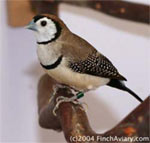|
PHOTOGRAPHY
TOPICS
|
||
|
|
|
|
|
How
to Photograph Birds in an Acrylic Aviary Photographing birds in an indoor acrylic (Plexiglas) aviary has its challenges. Although you do not have to concern yourself with the bars of a cage, you do have to contend with reflections and image degradation from the Plexiglas. In addition, an aviary is fixed, which means you frequently have to contend with the poor quality of indoor lighting, without the ability to move to a better location. Although our aviary includes two shop lights loaded with full spectrum bulbs (good quality light for keeping birds), it still does not measure up photographically with the quality of natural sunlight. Increasing the lighting in the room also increase the reflections in the Plexiglas, so this frequently is not an option. And remember, once you move your bird from a cage to an aviary and give them room to fly, they will do just that. A bird in a cage can't go anywhere. A bird in an aviary has flight at its disposal. To get the best results when shooting birds, I recommend using your camera's manual (or semi-manual) settings, if it has them. Today, even many consumer level cameras (both digital and film), offer you at least some manual capabilities. If not, they may offer shooting modes that may provide you with some control over which settings are used.
Click
Next to read about Exposure Issues |
HOME | CONSTRUCTION
| CARE | BIRDS
| ACCESSORIES | BACKGROUND
AVICAM | GALLERY
| GUESTBOOK | LINKS
| SEARCH
SITE MAP | DISCLAIMER
| CONTACT US
(c)2004 FinchAviary.com
